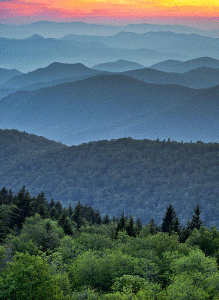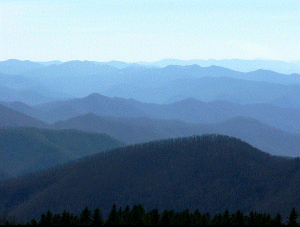I did not set out to write a multi-part series on the Blue Ridge Mountain evictions, but as the original post became longer and longer, I decided to split it into parts, all of which I will post in upcoming days.
My Blue Ridge Mountain Home Eviction: Part 1
 My great grandparents lived above the Shenandoah Valley, in the Blue Ridge Mountains of Virginia, a stretch of peaks, gaps, glens, hollows, creeks, coves, falls, meadows, forests, thickets, and woodland that reaches from Georgia to Pennsylvania. The mountains are like frozen swells of the ocean, billions of tons of rock and soil blown into soft curves by an eternity of wind and rain.
My great grandparents lived above the Shenandoah Valley, in the Blue Ridge Mountains of Virginia, a stretch of peaks, gaps, glens, hollows, creeks, coves, falls, meadows, forests, thickets, and woodland that reaches from Georgia to Pennsylvania. The mountains are like frozen swells of the ocean, billions of tons of rock and soil blown into soft curves by an eternity of wind and rain.
They’re the oldest mountains in the world, and there’s just not that much left of them. These days they rise only about 2,000 feet from the Shenandoah Valley floor, hardly an awe-inspiring height, and about what we out West would call a foothill. But while their height from sea level, 6,685 or so in their bare feet, isn’t inspiring, their serene beauty is.
 They are gentle, welcoming, not at all intimidating, as are our Sierras that separate California from the rest of the country like a knife edge.
They are gentle, welcoming, not at all intimidating, as are our Sierras that separate California from the rest of the country like a knife edge.
That’s what age does; it rounds our edges, softens our need to be the biggest or the toughest, slows us so we can see others, then opens our arms to welcome them.
Hundreds of years ago early settlers named this mountain range the Blue Ridge. It’s a beautiful name, and exactly the right one. The mist that shrouds its hillsides and hangs in its valleys colors the mountains in shades from dark sapphire to pale azure. Like undulating ribbons they lie in sequence, one overlapping the other, until they simply disappear into distance’s pale mist and you can see them no more.
All the mountains’ detail, the trees and rock outcrops, meadows and streams, fade into blue outlines of mountains. You can swear at times they are transparent, how the mist rises to leave nothing but the shape of a ridgeline in deeper blue than what lies either nearer or farther beyond it. 
In the 1400s Leonardo da Vinci noticed a blue haze hanging above the hills of Tuscany. He painted it, and the art historians called those backgrounds hesitant or insubstantial, that he painted them in haze so as not to divert focus from the central theme.
But it was not just a technique, it was a feature of Leonardo’s beloved Tuscan landscape. Da Vinci speculated in his notebooks that the blue haze might have been caused by minute and nearly invisible mists of water emitted from the trees.
There are two other mountain ranges in the world named for their blue mists, one in Australia and the other in Jamaica, and both named the Blue Mountains.
They and the Blue Ridge are all treed with woody plant species that emit their essential oils into the air around them. Known as isoprene, the oil creates the blue-tinged haze that give all three ranges their name.
There’s debate as to the reason the trees release their isoprene, but this we know: There is a purpose. Nature is economical. Nothing is given or taken without good reason.
One hypothesis is that isoprene protects the photosynthesis of tender leaves from heat stress. Yet once released, isoprene mixes with chemicals in the atmosphere to create ozone, which is harmful to the trees.
Science cannot yet explain this costly tradeoff. Perhaps if the genius painter Leonardo Da Vinci were around today he could. Some surmise that the blue haze he wrote of that hung over Tuscany was isoprene.
No matter. The beauty of the mist is not in its science, but in what it does to our souls when we view the mountains through its filtered light.  There is a profound silence telling you that secrets hide here, covered by mists and time and the forests that reclaim their pristine past.
There is a profound silence telling you that secrets hide here, covered by mists and time and the forests that reclaim their pristine past.
The secrets belong to our ancestors, those hearty people who traversed the ridges and crawled through the underbrush to finally come out on a flat or a meadow where they would build a home, a Blue Ridge home they never planned to leave.
You can read Part Two of My Blue Ridge Mountain Home Eviction here. Or access the whole series here. To make sure you don’t miss any installments, go to the “subscribe” form at the top of this page.

Pingback: Blue Ridge in My Blood | We're All Relative
Wonderful, I just began reading your post and highly look forward to reading all installments!
Thank you, Annie. You read the first, I’m up to number six now, of an eight-part series. I love learning all this family history as I go along, and I appreciate that you’re enjoying it!
Pingback: Blue Ridge: Oh, How They Lived! | We're All Relative
Pingback: What was Lost in the Blue Ridge | We're All Relative
Pingback: Blue Ridge: How Would I Like Eviction? | We're All Relative
Pingback: What Really Happened? | We're All Relative
Pingback: A Complex Tangle of Emotions | We're All Relative
Pingback: My Blue Ridge Family Tree (Album) | We're All Relative
I love how you tie in the biological and geological background on the Blue Ridge Mountain Region, like a true historical fiction (or non-fiction, of course) writer. I’ve often wondered about the reason the Blue Ridge appears as it does, but I’ve never run across an explanation before. The isoprene explanation is very interesting. I wonder if it is also a reason why blue has always been my most favorite colors, still not even supplanted by my newer favorites, green and orange and yellow.
I don’t know if isoprene is why your favorite color is blue, but you seem to be moving into fall colors now. 😉